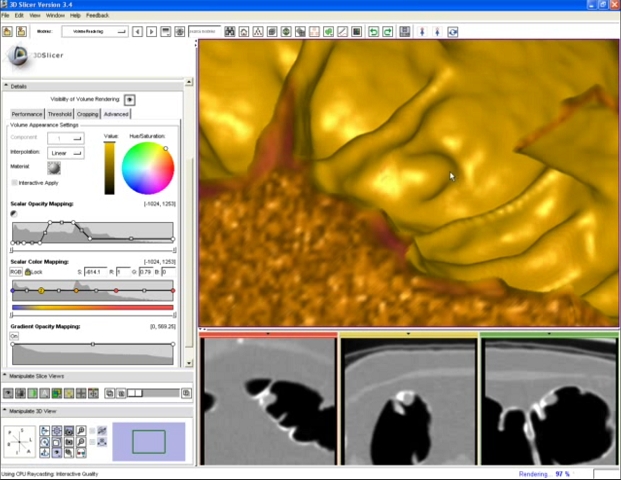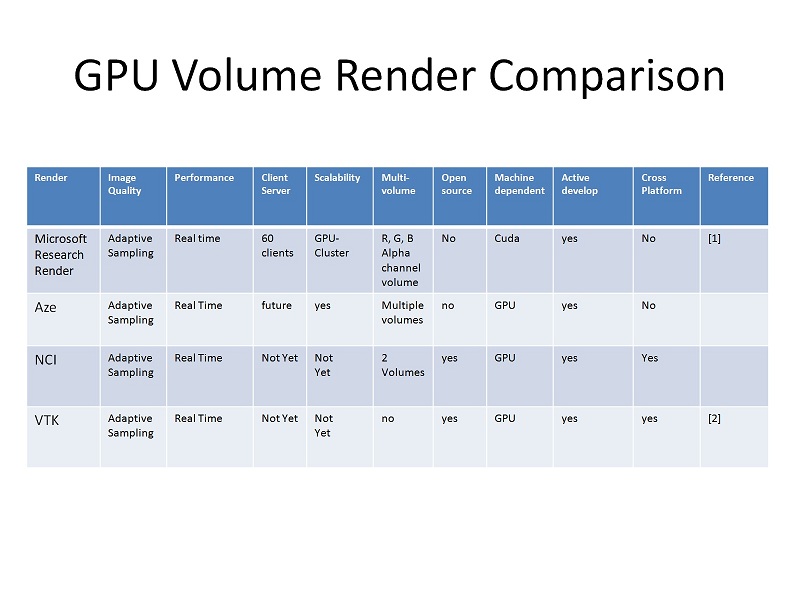Difference between revisions of "2010 NAMIC Project week: Real-Time Volume Rendering for Virtual Colonoscopy"
From NAMIC Wiki
| (11 intermediate revisions by 2 users not shown) | |||
| Line 1: | Line 1: | ||
__NOTOC__ | __NOTOC__ | ||
| − | + | ||
| − | + | [[File:VC-Slicer-75%.jpg]] | |
| − | |||
==Key Investigators== | ==Key Investigators== | ||
| − | * MGH: | + | * MGH: Yin Wu, June-Goo Lee, Hiro Yoshida |
| − | * BWH: Steve | + | * BWH/Isomics: Steve Pieper, Ron Kikinis |
| − | |||
<div style="margin: 20px;"> | <div style="margin: 20px;"> | ||
| Line 13: | Line 11: | ||
<h3>Objective</h3> | <h3>Objective</h3> | ||
| − | * | + | Pursure volume rendering that is suitable for real-time and interactive virtual colonoscopy display. |
| − | * | + | |
| − | * Compare the | + | The objectives of this project is to: |
| − | + | * Examine internal volume rendering engines (open source) availabel in Slicer | |
| + | * Provide external volume rendering engines (closed source) for virtual colonoscopy | ||
| + | * Compare the performance of these volume rendering engines. | ||
| + | * Compare the advantages and disadvantages of these volume rendering engines in real-time high-quality virtual colonoscopy navigation | ||
</div> | </div> | ||
| Line 23: | Line 24: | ||
<h3>Approach, Plan</h3> | <h3>Approach, Plan</h3> | ||
| + | Several virtual colonoscopy datasets will be rendered by use of the below volume rendering engines. | ||
| + | * VTK GPU Raycasting in Slicer 3.6 (GLSL) | ||
| + | * Microsoft research (MSR) volume rendering (CUDA, closed source) | ||
| − | + | The performance of these volume rendering engines will be compared based on various metrics, including the response to multitouch functions. | |
| − | |||
</div> | </div> | ||
| Line 32: | Line 35: | ||
<h3>Progress</h3> | <h3>Progress</h3> | ||
| − | + | The two volume rendering engines are installed on a single computer equipped with a CUDA-based GPU for rendering the virtual colonoscopy datasets and for performance comparison purposes. | |
</div> | </div> | ||
| Line 38: | Line 41: | ||
<div style="width: 97%; float: left;"> | <div style="width: 97%; float: left;"> | ||
| + | |||
| + | ==Namic Week Progress == | ||
| + | * Microsoft Research GPU Volume Render, vtk GPU render and NCI GPU Render are installed in the same computer to compare image quality and performance | ||
| + | * Latest ACE's GPU render features are demoed and has some feature comparison | ||
| + | * Multi-touch interface on Microsoft Research GPU render is tested, showing inital flying through features | ||
| + | * Center line of Colon created using 3D Slicer, although the process is very slow due to large segmente colon data | ||
| + | * Center line created from 3D Imaging Lab, MGH | ||
| + | * Four GPU Render Comparison table: | ||
| + | |||
| + | [[File:GPUCompare-50%.jpg]] | ||
==Delivery Mechanism== | ==Delivery Mechanism== | ||
| + | A table that shows a comparison of the above two rendering engines in terms of | ||
| + | * rendering performance and | ||
| + | * advantages and disadvantages in rendering virtual colonoscopy datasets in clinical settings | ||
| + | |||
| + | will be delivered. | ||
==References== | ==References== | ||
| − | + | * [1]http://research.microsoft.com/apps/pubs/default.aspx?id=132297 | |
| + | * [2]http://kitware.com/products/archive/kitware_quarterly0708.pdf | ||
</div> | </div> | ||
Latest revision as of 03:49, 25 June 2010
Home < 2010 NAMIC Project week: Real-Time Volume Rendering for Virtual ColonoscopyKey Investigators
- MGH: Yin Wu, June-Goo Lee, Hiro Yoshida
- BWH/Isomics: Steve Pieper, Ron Kikinis
Objective
Pursure volume rendering that is suitable for real-time and interactive virtual colonoscopy display.
The objectives of this project is to:
- Examine internal volume rendering engines (open source) availabel in Slicer
- Provide external volume rendering engines (closed source) for virtual colonoscopy
- Compare the performance of these volume rendering engines.
- Compare the advantages and disadvantages of these volume rendering engines in real-time high-quality virtual colonoscopy navigation
Approach, Plan
Several virtual colonoscopy datasets will be rendered by use of the below volume rendering engines.
- VTK GPU Raycasting in Slicer 3.6 (GLSL)
- Microsoft research (MSR) volume rendering (CUDA, closed source)
The performance of these volume rendering engines will be compared based on various metrics, including the response to multitouch functions.
Progress
The two volume rendering engines are installed on a single computer equipped with a CUDA-based GPU for rendering the virtual colonoscopy datasets and for performance comparison purposes.
Namic Week Progress
- Microsoft Research GPU Volume Render, vtk GPU render and NCI GPU Render are installed in the same computer to compare image quality and performance
- Latest ACE's GPU render features are demoed and has some feature comparison
- Multi-touch interface on Microsoft Research GPU render is tested, showing inital flying through features
- Center line of Colon created using 3D Slicer, although the process is very slow due to large segmente colon data
- Center line created from 3D Imaging Lab, MGH
- Four GPU Render Comparison table:
Delivery Mechanism
A table that shows a comparison of the above two rendering engines in terms of
- rendering performance and
- advantages and disadvantages in rendering virtual colonoscopy datasets in clinical settings
will be delivered.

